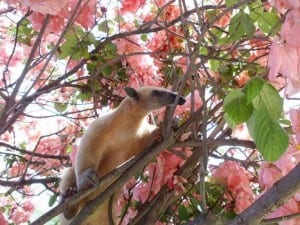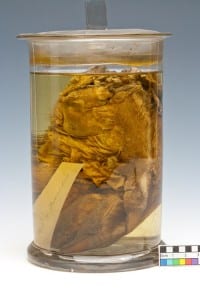Specimen of the Week 187: The Tamandua Hand
By Will J Richard, on 11 May 2015
Hello! Will Richard here, bringing you another Specimen of the Week.
This month I’ve decided to start with a reading from one of my poems.
I call this “Specimen”.
Ahem ahem.
The hand is in the jar.
The hand of a tamandua?
It might seem quite bleak as my choice for this week
but read on and you might just say “ahhh!”
Or you might not.
Either way, this week’s specimen of the week is…
**The tamandua manus**
1) The hand is in the jar
There’s no getting around it, the hand is in the jar. Anatomically, however, this is not merely a “hand” but also the distal portion of the fore limb, or manus. This term can be applied comparatively irrespective of taxa, which is essential given the variety of the pentadactyl (five fingered) limb. You wouldn’t call a horse’s hoof, a bird’s wing or an icthyosaur’s flipper a hand, for example.
Our specimen is actually quite hand-like and belonged to a tamandua or lesser anteater.
2) The hand of a tamandua?
Tamanduas are mostly tree-living, mostly nocturnal anteaters endemic to the rainforests of Central and South America. They have striking cream and black fur (usually) and because of their long claws they walk on the outside of their feet, giving them an ungainly but charming waddle when on the ground. In the trees, however, they are transformed and use those same claws and their prehensile tail to climb. They feed, as you would expect, on ants and termites, again using their claws to break open the nests of their prey. Their barbed tongue extends over 40 centimetres from their long snouts and they use this to feed on up to 9,000 insects a day. They have no teeth and can only open their mouth to the width of a pencil. This means they cannot chew but instead a tamandua’s stomach is portioned to include a muscular gizzard, so can grind down food after swallowing. As well as insects they eat fruit, honey and broken eggs. Basically anything you can find in a jungle and drink through a straw.
It has been hypothesised that their lack of teeth is another reason for their abundance of claws: they have nothing else to defend themselves with. When threatened, if escape is impossible, tamanduas will lean back on their tail to form a stable tripod with their two back legs. They can hold this “standing” position indefinitely and strike forwards with their front claws.
3) High four
Tamanduas, like many xenartharans (sloths, armadillos and anteaters), have different numbers of digits on their front and back limbs. In their case they have five on the “feet” and four on the “hands”. So we know this is a manus simply by counting the fingers (not toes). Which manus can be determined by the angle and order of the digits and the orientation of the paw’s pad all of which is reversed depending on the animal’s side. This is a left manus.
4) Whose tamandua?
We know little about the origin of this specimen. The only information originally attached to it is a simple handwritten note that reads “tamandua foot”, firstly vague and then just wrong. Given that there are two recognised species: the southern (Tamandua tetradactyla) and the northern (Tamandua mexicana) we can go no further than genus (Tamandua) as a certain identification. So, let’s be uncertain.
5) North and South
The two species are split by their geography, they switch from the northern to the southern about halfway through Colombia. The southern tamandua, particularly towards the south of the species range (northern Argentina and southern Brazil), is much lighter with little or no black fur at all. The darker colouration with small lighter patches around the top of the digits on this specimen is, therefore, indicative of the more intensely patterned northern variety. Or, at least, of a northern southern tamandua. Both species are of a similar size, with little difference in the morphology of the manus. Without starting down the DNA testing route therefore, we can go no further. And even if we did do this there is no guarantee it would help. Time and high concentrations of alcohol (in which specimens are preserved) can damage the cellular structure of the soft tissue and so the DNA strands within. In some (probably most) cases this renders it impossible to extract any genetic material.

southern tamandua (Tamandua tetradactyla) by Luis Alejandro Cisneros; CC BY-SA 3.0 via Wikimedia Commons. Note the difference in coat pattern when compared to the previous images.
So, given the evidence to hand, this is almost certainly not the manus of a southern southern tamandua. It could be the manus of a northern southern tamandua, a southern northern tamandua or even a northern northern tamandua.
All seems pretty clear to me.
References:
Taylor, K. B.; 1978; The anatomy of the forelimb in the anteater (Tamandua) and its functional implications; Journal of Morphology; 157; 3; 249–367
Spigelman, M., Bames, I., Holton, J., Vaira, D., Thomas, M. G.; 2001; Long-term DNA survival in ethanol-preserved archival material; Ann R Coll Surg Engl; 83; 283-284
Will Richard is Visitor Services Assistant at the Grant Museum of Zoology
 Close
Close




